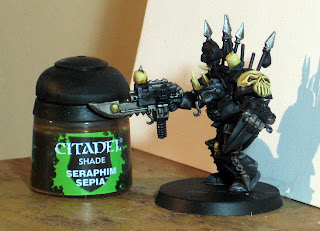Painting black armour (or white, for that matter) always poses a problem, because you're typically missing out on either a shade or a highlight. If your midtone is white, you've got nowhere to go for a highlight. If your midtone is black, you have nowhere to go for a shade. So, what's the answer to this? For me, it's to fake to an "almost black" (and likewise, an "almost white" in the other case). Given that the new Chaos Codex came out a little bit ago, I got bitten by the bug again to get back to my Black Legion. It also helps that I just recently switched jobs to a much more sane work schedule, allowing me time to actually enjoy a hobby again, praise the Emperor.
So I've been playing around with the new paints, and I kinda like them. The "dry" paints were weird at first, but I'm really starting to dig them. In my playing around, I've found the basic guide on GW's site to actually be quite helpful (
Link). Their color suggestions for "sheer black" looked promising, but after trying it out, I preferred a different order...
Step 1: Abaddon Black
Or the old "chaos black" ... same thing, new name. I generally base the whole model with this, so I rarely even call it a "step"
Step 2: Eshin Grey
I painted this over all areas that I intend to make black, while keeping it out of crevices. This is our mid-tone black, which will be made darker after the last step.
Step 3: Dawnstone
This is our first highlight. I use it to line the edges of armour that is in dark areas, and lay it on a little thicker in areas that should be brighter due to light source.
Stpe 4: Longbeard Grey
This is our second highlight. Use it sparingly, and only in areas that really need it. For example, if it's an area that was heavily applied with Dawnstone due to light-sourcing, then edge with Longbeard. If it's a darker area where you only edged with Dawnstone, don't use Longbeard.
Step 5: Nuln Oil
This should bring everything back down to a darkness that is favorable for black armour. In addition, it helps the different greys blend in a little more. We're using it as a shade AND a glaze! Bonus! :D
It might be a little hard to really see the "black" because the rest of the model is still left in its Abaddon Black basecoat, and is thus darker, so...
Here's the finished model to give you an idea of how that black fits in with the rest. It's not really the final step for this particular model, to be honest, because I like my Khorne Berzerkers a bit bloodsplattered ... but skipping straight to that step would kinda defeat the purpose of showcasing the black armour.
And here's the blood-splattered version, in-case you were wondering. :)
Let me know what you think!











